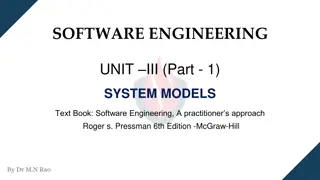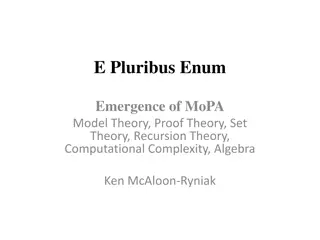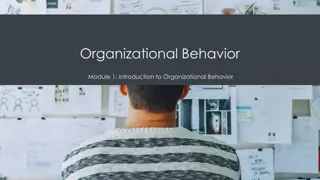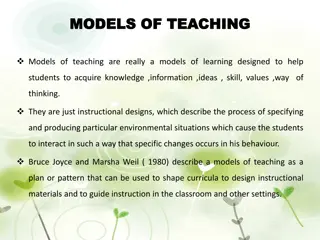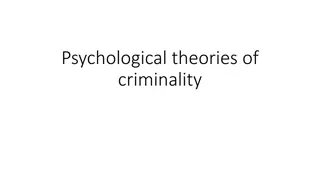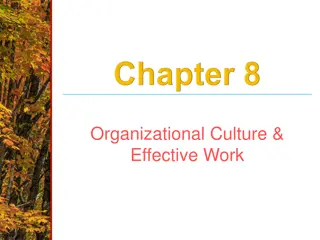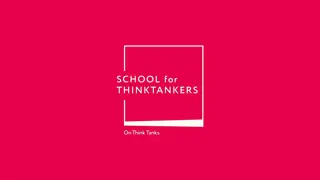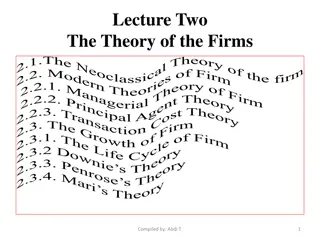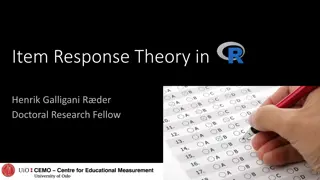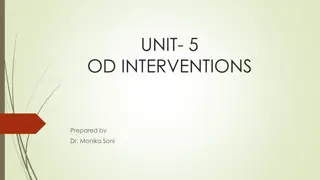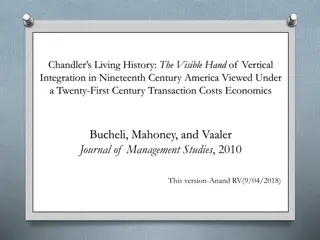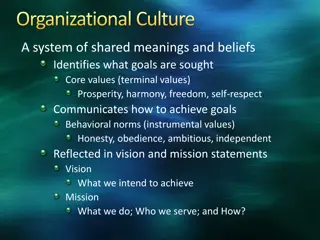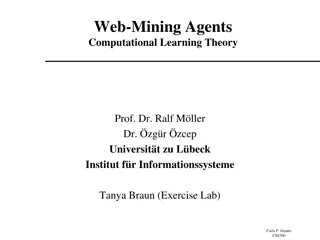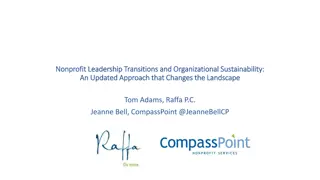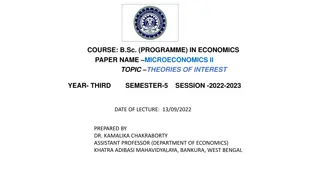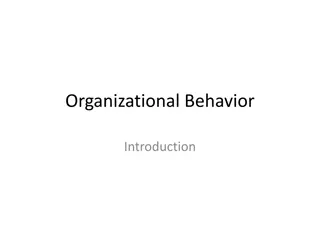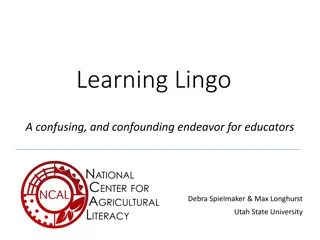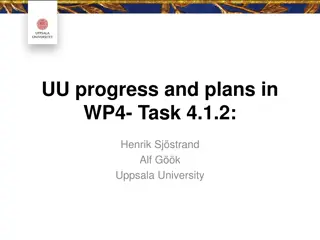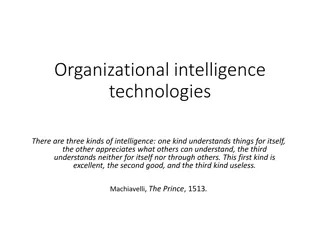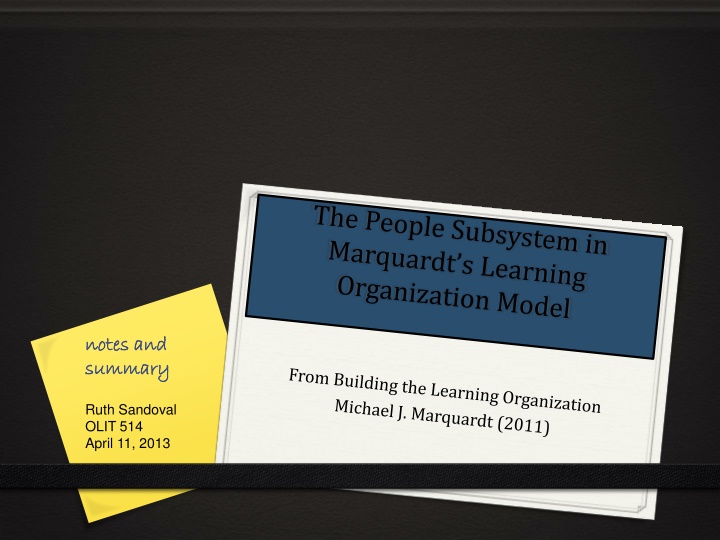
Marquardt's System Learning Organization Model
Explore Marquardt's System Learning Organization Model, focusing on its components like the Learning Subsystem and People Subsystem. Discover how empowering and enabling individuals within an organization supports learning, along with the top 10 strategies for building learning subsystems.
Download Presentation

Please find below an Image/Link to download the presentation.
The content on the website is provided AS IS for your information and personal use only. It may not be sold, licensed, or shared on other websites without obtaining consent from the author. If you encounter any issues during the download, it is possible that the publisher has removed the file from their server.
You are allowed to download the files provided on this website for personal or commercial use, subject to the condition that they are used lawfully. All files are the property of their respective owners.
The content on the website is provided AS IS for your information and personal use only. It may not be sold, licensed, or shared on other websites without obtaining consent from the author.
E N D
Presentation Transcript
n notes and otes and summary summary Ruth Sandoval OLIT 514 April 11, 2013
Marquardts System Learning Organization Model Marquardt s System Learning Organization Model is based on over 25 years experience with and study of learning organizations. The model includes and builds on systems models brought forward by others in the study of Organizational Learning including Chris Agyris, Donald Schon, and Peter Senge. Marquardt s model is made up of 5 individual, but not separate sub-systems. He discusses that learning takes place at the levels of the individual, group, and organization and that there are types of learning that take place as well as skills utilized within this model. Each part of Marquardt s model is a component of the whole learning organization system. In his book, Building the Learning Organization (2011), he states that all five are necessary to sustain viable, ongoing organizational learning . And his study indicates that all five of the sub-systems are dynamically related and complement one another
The Learning Subsystem Learning People Organization LEVELS Individual learning informs/feeds/affects group Group/Team learning informs organization Organizational learning/transformation TYPES -Adaptive-Individual/group/organization reflects on past experience to modify future actions. (what has been done? What can be done?) -Anticipatory-Acquiring knowledge from envisioning various futures. (what are the possible outcomes or paths?) -Action-Learning while engaging in action (learn as you experience) SKILLS -Systems Thinking-Conceptualize bigpicture of systems in place in order to modify and improve. - Mental models-Assumptions/ideas -Personal Mastery-Individual proficiency/learning - Self-Directed -Dialogue-Listening and communication between individuals Knowledge Technology
The People Subsystem Enabling and Empowering individuals within the organization The People sub-system - represents how empowering and enabling people impacts and drives learning in an organization.
How does empowering and enabling people support learning? People Managers Leaders Employees Marquardt says that only people are able to learn. They are able to take information and transform it into valuable knowledge for the organization. Community Suppliers Each of these groups must be empowered and enabled. If they are empowered but not enabled, they will have the necessary resources at their disposal,. But not the knowledge to effectively use them Partners and Alliances Customers
Marquardts top 10 strategies for building Learning Subsystems 1. Develop Modular, exciting, and portable learning content 2. Increase organization s ability to learn how to learn 3. Develop the discipline of organizational dialogue 4. Design Career Development plans for employability 5. Establish Self-development programs 6. Build team learning skills 7. Encourage and practice systems thinking 8. Utilize scanning and scenario planning 9. Expand multicultural and global mind-sets and learning 10. Change the mental models of learning HOW CAN THESE STRATEGIES BE APPLIED TO ENHANCE LEARNING ?
Example-Research and identify a strength-based training program such as Gallup s Strengths Quest to bring to organization s leaders empowering and enabling them to work from new and innovative mental models. They, in turn, can bring the new models to employees, customers, partners, suppliers, shifting the people in the organization to a learning mind set. Train employees to train others giving them the authority and knowledge to sustain the learning organization. Tools for Empowering/ Enabling Managers/Leaders Shift to roles of leadership from Authoritative Leadership style to role of Coach, Mentor, Co-Learner, supporting and enabling others to learn. Engage in systems thinking, acknowledge and challenge mental models, and encourage creativity and employee involvement. Example-Design time in leadership meetings for regular organizational visioning time, discussion of mental models, open time to challenge and test the current mental models. Create expectation for leadership to model this regularly for team meetings with peers and employees. Example-Inspire and promote Action Learning by training leadership to engage employees in processes of solving complex issues and challenges. This can be accomplished by enlisting task teams to brainstorm, share innovative ideas, and solve issues as they occur. Give employees the authority to carry out solutions in a real-time fashion to directly affect outcomes. INCREASE ABILITY TO LEARN HOW TO LEARN-MENTAL MODELS- ENCOURAGE AND PRACTICE SYSTEMS THINKING-DEVELOP ORGANIZATIONAL DIALOGUE-BUILD TEAM LEARNING
Tools for Empowering/Enabling Employees Treat employees as creative and resourceful adults with the capacity to learn. Offer freedom and support. Delegate authority and responsibility so that the people closest to the challenge are able to manage and solve issues. Involve them in developing strategies. Balance individual and organizational needs by offering career advancement opportunities, professional development, wellness and health resources. Example: Delegate authority and responsibility by breaking down project into smaller parts and creating teams to manage them. Work with teams to require accountability and innovation while fostering a safe learning environment. Example-Create, conduct, study a survey to examine employee perceptions of the balance between individual and organizational needs. Involve employees to create sustainable systems for individual health and wellness to create and maintain balance for optimum productivity. Example-Implement a self-service process for employee development, training and advancement to empower individuals to work from their interests, strengths and abilities. Promote from within this pool of strengths-based individuals whenever possible. MENTAL MODELS-SHARED VISION-TEAM LEARNING SKILLS- SELF DEVELOPMENT PROGRAMS-SYSTEMS THINKING-CAREER DEVELOPMENT PLANS
Empowering/Enabling Business Alliances and Partners Create a learning environment with business partners through training and advisory committees: Suppliers and Vendors Create a learning environment with suppliers and vendors through information, training: Example-Offer video training, presentations, orientations to suppliers and vendors that bring the learning culture to them. If certifications are available, offer what is possible with the technology at hand. Provide a forum for feedback and innovation. Example-Form an advisory committee team on which business partners can serve and share valuable industry information, feedback, and where they can participate creatively in innovative processes. Provide training, orientation to partners to promote a shared vision of the partnership, current mental models, discussion. SYSTEMS THINKING-MENTAL MODELS-SELF DEVELOPMENT SHARED VISION- MENTAL MODELS-TEAM SKILLS
Empowering/Enabling Community Customers Partner with diverse areas of community to educate and inform about the organization creating a learning culture within community: Empower customers by offering participation in process and end product. Example-work with local schools and clubs to share mission and vision of organization by teaching, presenting, discussing. Encourage others in the community to come into organization for training, and sharing expertise. Provide a forum for suggestions and feedback encouraging dialogue and shared vision with community members. Example-Create focus groups of in which customers have input and ability to contribute to process and product of organization. Allow these groups to have an impact on processes and end product Offer training and forum for discussion. MENTAL MODELS-SELF DEVELOPMENT PLANS- MULTICULTURAL AND GLOBAL MIND SETS-SYSTEMS THINKING-PORTABLE LEARNING CONTENT TEAM LEARNING SKILLS-MENTAL MODELS-SYSTEMS THINKING-MULTICULTURAL AND GLOBAL MIND SETS INCREASE ABILITY TO LEARN-PORTABLE LEARNING CONTENT
Resources Books Building the learning organization, 3rd edition: Achieving Strategic Advantage Through a Commitment to Learning, Michael J. Marquardt This summary is based mostly on Marquardt s book. Easy to read and invaluable to use as a reference. Video Michael Marquardt Action Learning LecturePublished on Feb 1, 2013 http://www.youtube.com/watch?v=ZtVG8kF8qf 4 Good discussion of elements of Action Learning The Fifth Discipline-The Art and Practice of the Learning Organization, Peter M. Senge, Introduction and guide to organizational disciplines-Personal Mastery, Mental Models, Shared Vision, Team Learning. Thinking in Systems: A Primer, Donella H. Meadows Good for shifting to new thought processes in systems thinking Co-Active Coaching-Changing Business, Transforming Lives, Karen and Henry Kimsey- House, Phillip Sandahl and Laura Whitworth The best guide to coaching practices I have ever read Strengths Quest, Clifton, Anderson An introduction and guide to a strength-based approach to empowering people with a code to take the Clifton Strengths Finder survey Websites 2010. e-Global Organizations Transformations. http://www.mszscience.info/learning_org_hb/learning_org_hb8.html Nice guide for implementation of Marquardt s subsystems How Can I empower Employees? http://www.entrepreneur.com/article/217880 An interview with tips for employee empowerment
References Clifton, Donald O., Anderson, Chip. (2006) Strengths Quest. New York, Gallup Press. Empowerment: a Necessary Attribute of a Learning Organization? Bijaya Mishra, A.Uday Bhaskar. ISSN 2029-4581. Organizations and Markets in Emerging Ecomomies, 2010, VOL. 1, No. 2(2) Kimsey-House, Henry, Kimsey-House, Karen, Sandahl, Phillip, Whitworth, Laura. (2011) Co- Active Coaching, Boston, Nicholas-Bradley Publishing. Marquardt, M. J. (2011). Building the Learning Organization. Boston, MA: Brealey Publishing, p. 121-154. O'Leary, D.E. (1998). Reengineeting and knowledge management. In D. Fensel and R. Studer (eds) Lecture Notes in Computer Science, Springer, p 1-12. Salisbury, M. (2009). iLearning: How to create an innovative learning organization. San Francisco, CA: Pfeiffer Publishing, p. 67-76. Senge, Peter M. (1990). The Fifth Discipline. New York, Doubleday. 2010. e-Global Organizations Transformations. http://www.mszscience.info/learning_org_hb/learning_org_hb8.html

